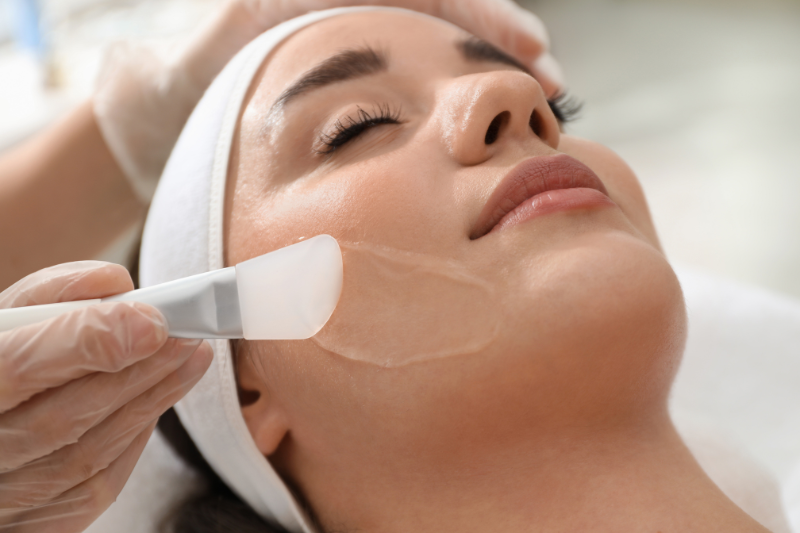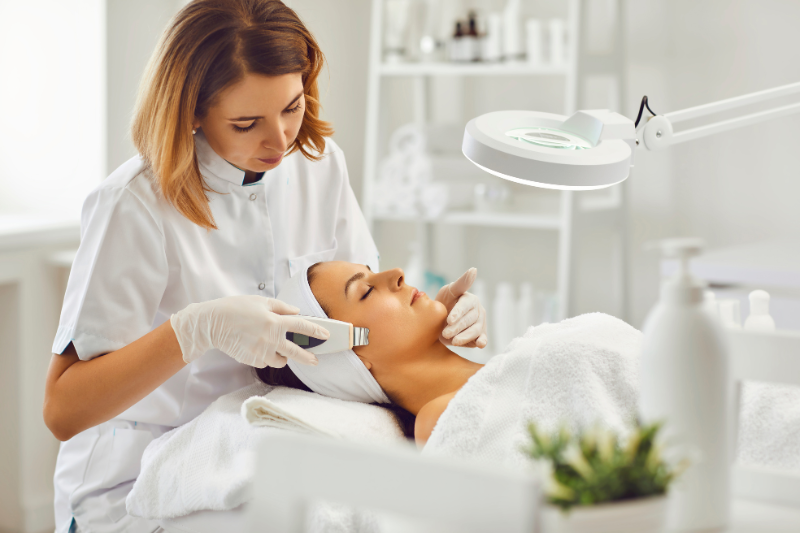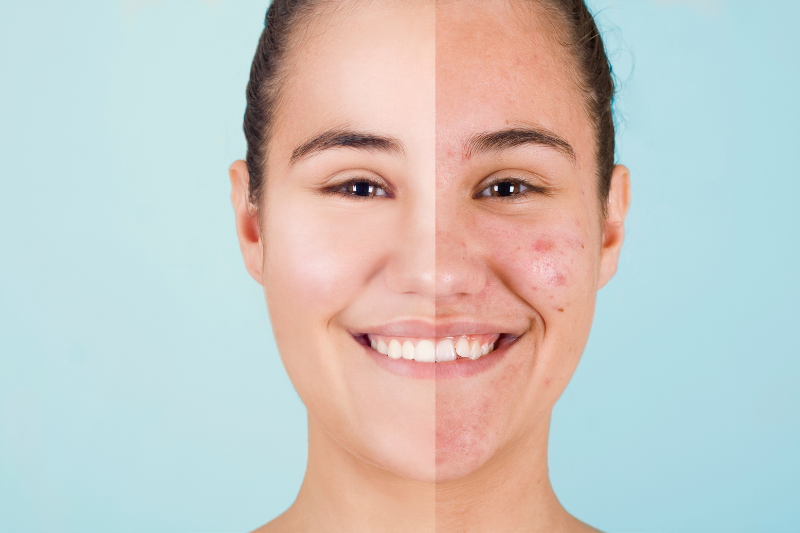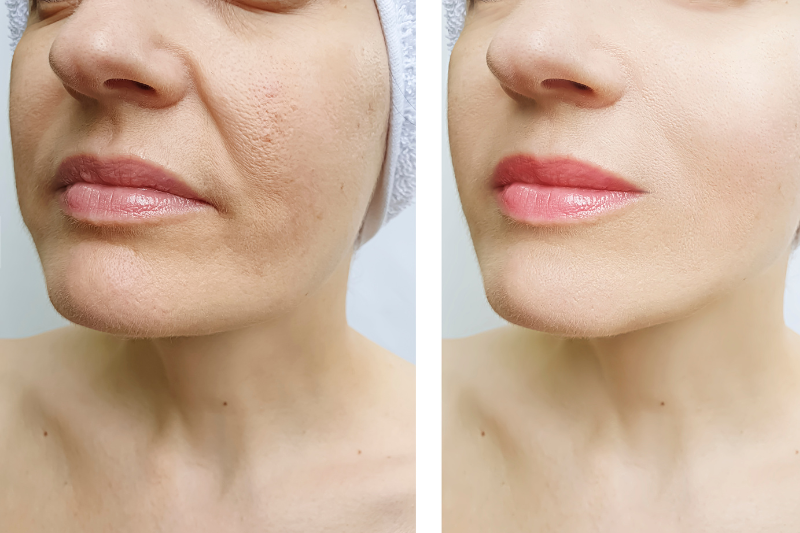Chemical Peel Overview
Chemical peels are becoming increasingly popular in skincare routines worldwide, offering a range of benefits from reducing wrinkles to treating acne.
According to the American Society of Plastic Surgeons (ASPS), over 1.3 million chemical peel procedures were performed in the United States in 2023 alone, showcasing a growing interest in this skin treatment.
But what exactly are chemical peels, and are they good for your skin? Let’s explore.
Is a Chemical Peel Good for Your Skin?
Chemical peels can be incredibly beneficial for the skin, depending on the specific skin issues you want to address. They work by removing the outermost layers of the skin, allowing fresh, new skin to emerge.
This process can help with a variety of skin concerns, such as fine lines, acne, hyperpigmentation, and uneven skin texture. However, it’s essential to consult with a dermatologist to determine if a chemical peel is right for you.
What Does a Chemical Peel Do?
A chemical peel involves applying a solution to the skin, which causes it to exfoliate and eventually peel off. The new skin underneath is usually smoother, less wrinkled, and more even in tone. There are different types of peels, varying in strength, that can target specific skin concerns. These peels can be done on the face, neck, or hands.
Is Chemical Peeling Good for the Face?
Yes, chemical peeling can be very effective for facial skin. It can help reduce the appearance of wrinkles, sun damage, acne scars, and age spots. Additionally, it can improve the overall texture and tone of the skin, giving it a more youthful and radiant appearance.
Are Facial Peels Good for Your Face?
Facial peels can be beneficial, but they are not without risks. While they can address a variety of skin issues, they can also cause redness, irritation, and in some cases, more severe side effects like scarring or infection.
It’s crucial to have a professional assess your skin type and concerns before undergoing a chemical peel to ensure it’s safe and effective for you.
What Are the Benefits?
Chemical peels offer numerous benefits, including:
Reduction of Fine Lines and Wrinkles
By removing the outer layers of skin, peels can help reduce the appearance of fine lines and wrinkles.
Treatment of Acne and Scars
Certain peels can help reduce acne and lighten acne scars.
Improvement in Skin Texture and Tone
Chemical peels can make the skin smoother and more even-toned.
Reduction of Hyperpigmentation
Peels can help lighten dark spots and improve overall skin tone.
According to a 2023 study published in the Journal of Clinical and Aesthetic Dermatology, chemical peels are among the most effective non-invasive treatments for improving skin texture and tone, with a high patient satisfaction rate of over 85%.
Can Chemical Peels Be Used for Acne Treatment?
Yes, they can be highly effective in treating acne. Peels that contain salicylic acid, glycolic acid, or other exfoliating agents can help unclog pores, reduce oil production, and decrease inflammation, leading to fewer breakouts. They can also help fade acne scars, giving the skin a more even appearance.
How Do Chemical Peels Work on Different Skin Types?
It can work on various skin types, but the results and risks of treated skin may differ. For instance:
Oily Skin
Peels with salicylic acid are often recommended for oily skin because they can penetrate oil-clogged pores.
Dry Skin
Glycolic acid peels can be beneficial for dry skin, as they help to exfoliate and hydrate the skin.
Sensitive Skin
People with sensitive skin may need to opt for milder peels, such as lactic acid peels, to avoid irritation.
Darker Skin Tones
Those with darker skin tones need to be cautious, as some peels can cause hyperpigmentation. Milder peels on thicker skin are often recommended.
It’s essential to consult with a dermatologist who understands how different skin types respond to chemical peels to choose the most appropriate treatment.

Types of Chemical Peels
What is a TCA Chemical Peel?
A Trichloroacetic Acid (TCA) chemical peel is a type of medium-strength peel that penetrates deeper into the skin than lighter peels. It’s used to treat various skin issues, including sun damage, hyperpigmentation, and fine lines. TCA peels can offer more dramatic results compared to lighter peels but also come with a longer recovery period.
Is TCA Peel the Strongest?
While TCA peels are strong, they are not the strongest available. Deep peels, such as phenol peels, penetrate deeper into the skin and provide more significant results but also carry more risks and a longer recovery time.
TCA peels offer a good balance between effectiveness and recovery time, making them a popular choice for those looking for substantial results without extended downtime.
What is a TCA Peel Good For?
TCA peels are good for treating moderate to severe skin issues, such as:
Sun Damage
TCA peels can help the skin color and reduce the appearance of sunspots and other forms of sun damage.
Fine Lines and Wrinkles
This type of peel can reduce the appearance of fine lines and wrinkles on black skin, particularly around the eyes and mouth.
Hyperpigmentation
TCA peels can lighten dark spots and improve overall skin tone.
Acne Scars
TCA peels can help reduce the appearance of acne scars by promoting the growth of new, healthy skin.
What is the TCA Solution Used For?
The TCA solution is used in chemical peels to exfoliate the skin and remove damaged layers. Dermatologists also use it on the face, neck, and other parts of the body to improve the skin’s appearance because of damaged skin cells. TCA solutions formulated in different strengths, depending on the depth of the peel desired.
Which is Better, TCA or Glycolic Peel?
The choice between a TCA and a glycolic peel depends on your skin concerns and desired results.
Glycolic Peels
These are lighter and better suited for those looking to improve mild skin concerns, such as uneven texture and dullness. They are also ideal for those with sensitive skin or those new to chemical peels.
TCA Peels
These are stronger and better suited for more severe skin concerns, such as deep wrinkles, significant sun damage, and stubborn hyperpigmentation.
Which is Better, Facial or Chemical Peel?
Both serve different purposes. Facials are gentler and focus on cleansing, moisturizing, and massaging the skin. They are ideal for maintaining healthy skin and providing a temporary glow.
Whereas, peels are more intensive and aim to address specific skin concerns by removing damaged layers of skin. They offer longer-lasting results but require more recovery time.
Is TCA safe for the face?
Yes TCA is safe for the face when done by a qualified professional. However, because TCA peels are stronger they carry more risks than lighter peels. Redness, swelling, and in rare cases scarring or infection. You must follow aftercare instructions carefully to minimize risks.
What’s the Difference Between Light, Medium, and Deep Chemical Peels?
The main difference between Light, Medium, and Deep chemical peels is the depth of skin penetration during the peel and the recovery time:
Light Peels
Remove the top and outer layer of skin and are good for mild skin issues like fine lines and uneven texture. Recovery time is minimal, just a few days.
Medium Peels
Penetrate deeper into the skin to address more serious issues like wrinkles and sun damage. Recovery time is a week.
Deep Peels
These treatments penetrate the deeper layers of the skin, targeting severe skin issues like deep wrinkles and sun damage. Recovery time is several, up to eight weeks, and carries more risks.
How Does a Glycolic Acid Peel Compare to a Salicylic Acid Peel?
Glycolic Acid Peels
These are water-soluble and work well for exfoliating the skin, improving texture, and reducing fine lines. They are typically used for dry or sun-damaged skin.
Salicylic Acid Peels
These are oil-soluble and are particularly effective for treating acne. They penetrate oil-clogged pores to reduce breakouts and inflammation.
Both peels have their benefits, and the choice between them depends on your skin type and concerns.
Are There Natural Alternatives to Chemical Peels?
Yes, there are natural alternatives to chemical peels, although they may not provide as dramatic results. Some options include:
Enzyme Peels
These use natural enzymes from fruits like papaya or pineapple to exfoliate the skin gently.
AHA/BHA Products
Products containing natural alpha-hydroxy acids (AHAs) or beta-hydroxy acids (BHAs) can provide mild exfoliation and improve skin texture.
Manual Exfoliation
Regular exfoliation with a gentle scrub can help remove dead skin cells and improve the skin’s appearance over time.
These natural alternatives can be a good option for those with sensitive skin or those who prefer a more gradual approach to skincare.

Chemical Peel Procedure and Experience
What Happens During a Chemical Peel?
The skin is first cleansed to remove any oils or impurities. Then the chemical solution is applied to the skin with a brush, cotton ball, or sponge. The solution is left on the skin for a certain amount of time depending on the strength of the peel. You may feel a slight tingling or burning during this time. After the time is up the solution is neutralized or removed and a soothing lotion or cream is applied to the skin.
What Does Your Face Look Like 3 Days After a Chemical Peel?
Three days after a chemical peel your face may look red and swollen like a sunburn. You may also see the skin start to peel or flake off which is normal as the old damaged skin is shedding and new skin is emerging. Don’t pick or pull at the peeling skin to prevent scarring.
Is a Chemical Peel Painful?
The level of pain during a chemical peel depends on the strength and medium depth of the peel. Light peels are very minimal, medium peels are burning or stinging, and deep peels can be more painful. Your dermatologist may use a cooling fan, cold compresses, or topical anesthetics to help with the discomfort during the procedure.
How Long Does it Take for a Chemical Peel to Heal?
The healing time after a chemical light peel varies depending on:
- Light Peels – Healing time is typically 3-7 days.
- Medium Peels – Healing time is around 7-14 days.
- Deep Peels – Healing can take 2-3 weeks or longer.
During the healing process, it’s important to follow aftercare instructions, such as avoiding sun exposure and using gentle skincare products.
Are There Any Special Aftercare Tips for Chemical Peels?
After a chemical peel, it’s important to:
Avoid Sun Exposure
Your skin will be more sensitive to the sun, so it’s crucial to use a broad-spectrum sunscreen and avoid direct sun exposure.
Moisturize Regularly
Keeping your skin moisturized can help soothe any irritation and promote healing.
Avoid Picking or Scratching
Let the skin peel off naturally to avoid scarring or infection.
Follow Dermatologist’s Instructions
Your dermatologist may recommend specific skincare products or routines to follow after your peel.
Can You Wear Makeup After a Chemical Peel?
It’s generally advised to avoid wearing makeup immediately after a chemical peel, especially for the first few days. Once the initial redness and peeling have subsided, you can start wearing makeup again. However, it’s best to use gentle, non-comedogenic products to avoid irritating the skin.
What Should You Expect During the Recovery Period After a Chemical Peel?
During the recovery period, your skin will be sensitive and may appear red or swollen. You may also experience peeling or flaking as the old skin is shed. It’s important to avoid sun exposure, use gentle skincare products, and follow any additional aftercare instructions provided by your dermatologist.

Chemical Peel -Effectiveness and Results
How Long Do Chemical Peel Results Last?
The results of a chemical peel can last anywhere from several months to several years. Depending on the type and depends on how well you take care of your skin afterward. Regular skin care and sun protection can help prolong the results of your peel.
- Light Peels: Results can last several months, but demonologists recommend regular treatments to maintain the benefits.
- Medium Peels: Results can last up to a year or more, with proper skincare and sun protection.
- Deep Peels: Results can last several years, but these peels are more invasive and require longer recovery times.
Is a Deep Chemical Peel Worth It?
A deep chemical peel can be worth it for those with severe skin concerns, such as deep wrinkles or significant sun damage. To provide more dramatic and long-lasting results, but they also come with more risks and a longer recovery period. It’s important to weigh the benefits against the potential risks and recovery time before deciding on a deep peel.
Do Chemical Peels Help with Hyperpigmentation?
Chemical peels can be very effective in treating hyperpigmentation. Peels that contain ingredients like glycolic acid, salicylic acid, or TCA can help lighten dark spots and even out skin tone. However, those with darker skin tones should be cautious, as stronger peels can sometimes cause post-inflammatory hyperpigmentation.
What Results Can You Expect from a TCA Peel?
From a TCA peel, you can expect:
Reduction of Fine Lines and Wrinkles
TCA peels can smooth out fine lines and wrinkles, particularly around the eyes and mouth.
Improved Skin Texture
The peel can help make the skin feel smoother and more even in texture.
Reduced Hyperpigmentation
TCA peels can lighten dark spots and improve overall skin tone.
Reduced Acne Scars
The peel can help fade acne scars and improve the appearance of the skin.
How Soon Will You See Results After a Chemical Peel?
Results from a chemical peel visible once the skin has fully healed, which can take anywhere from a few days to a few weeks, depending on the depth of the peel. Initially, your skin may appear red or swollen, but as it heals, you’ll notice smoother, more even-toned skin.
Can Chemical Peels Improve Skin Texture and Tone?
Yes, chemical peels are highly effective at improving skin texture and tone. By removing the damaged outer layers of skin, chemical peels reveal fresher, healthier skin underneath. This can help with issues like rough skin texture, uneven skin tone, and hyperpigmentation.

Cost and Accessibility
How Much Does a TCA Peel Cost?
A TCA peel typically costs between $300 and $1,000, depending on the concentration of the TCA solution and the provider. It’s important to consult with a qualified professional to get an accurate estimate for your specific treatment.
Are Chemical Peels Covered by Insurance?
Generally, chemical peels considered cosmetic or cosmetic surgical procedures. Therefore, not covered by insurance. However, if a peel is performed to treat a medical condition. Such as severe acne, some insurance plans may provide partial coverage. It’s best to check with your insurance provider to understand your coverage options.
Where Can You Get an Affordable Chemical Peel?
Affordable chemical peels can be found at dermatology clinics, medical spas, and some plastic surgery offices. It’s important to choose a reputable provider with experience in performing chemical peels to ensure safe and effective results. Some providers offer package deals or discounts for multiple sessions, which can help reduce the overall cost.
What is the Average Cost of a Chemical Peel?
The cost of a chemical peel can vary depending on the type of medium chemical peel used, the provider, and the location. On average:
Light Peels
$150 to $300 per session.
Medium Peels
$300 to $1,000 per session.
Deep Peels
$1,000 to $3,000 per session.
Are There At-Home Chemical Peel Kits, and Are They Effective?
There are at-home chemical peel kits available, but they are generally milder than professional peels. While these kits can provide some benefits, such as improved skin texture and tone, they are not as effective as professional treatments. It’s also important to use at-home peels with caution, as improper use can lead to skin irritation or damage.

Safety, Risks, and Considerations
What is the Downside of Chemical Peels?
While chemical peels offer many benefits, they also come with potential downsides, including:
Redness and Swelling
The skin may be red and swollen for several days after a peel.
Peeling and Flaking
The skin will peel or flake as it heals, which can be uncomfortable and unsightly.
Risk of Scarring
In rare cases, chemical peels can cause scarring. Particularly if the skin is picked or scratched during the healing process.
Hyperpigmentation
Some people may experience darkening of the middle layer of skin after a peel, especially those with darker skin tones.
Is TCA Safe for the Face?
TCA is generally safe for the face when used by a qualified professional. However, because it is a stronger peel, it carries more risks than lighter peels. It’s important to follow aftercare instructions carefully and avoid sun exposure to minimize the risk of complications.
Who Should Avoid Chemical Peels?
Chemical peels may not be suitable for everyone. People who should avoid chemical peels include:
Active Infections
For individuals having an active skin infection or open wounds. Then it’s best to wait until the skin has healed before undergoing a peel.
Pregnant or Breastfeeding Women
Certain chemicals used in peels may not be safe during pregnancy or breastfeeding.
History of Scarring
Individuals having a history of keloids or other types of scarring may be at a higher risk of scarring from a chemical peel.
Certain Skin Conditions
People with conditions like eczema or psoriasis should consult with a dermatologist before getting a peel.
Are There Risks of Scarring with Chemical Peels?
While scarring from chemical peels is rare, it is a potential risk, particularly with deeper peels. Scarring from superficial peels is more likely to occur if the skin is picked or scratched during the healing process or if the peel is not performed by a qualified professional. It’s important to follow aftercare instructions carefully to minimize the risk of scarring.
Can Chemical Peels Cause Long-term Damage to the Skin?
When performed by a qualified professional, chemical peels are generally safe and do not cause long-term damage to the skin. However, improper use of light peels, or overly aggressive peels can lead to complications such as scarring, hyperpigmentation, or infection. It’s important to choose a reputable provider and follow aftercare instructions to ensure a safe and effective treatment.

Chemical Solution FAQs
Can You Combine Chemical Peels with Other Skin Treatments?
Yes, chemical peels can be combined with other skin treatments, such as cosmetic treatments such as microneedling, laser therapy, or injectables like Botox or fillers. Combining treatments can enhance results, but it’s important to consult with a dermatologist. To determine the best treatment plan for your skin type and concerns.
How Often Should You Get a Chemical Peel?
The frequency of chemical peels depends on the type of peel and your skin concerns.
- Light Peels – Can be done every 4-6 weeks.
- Medium Peels – Can be done every 3-6 months.
- Deep Peels – These are typically done once and do not require repeat treatments.
Chemical peels are a versatile and effective skincare treatment that can address a variety of skin concerns, from fine lines and wrinkles to acne and hyperpigmentation. By understanding the different types of chemical peels, the procedure, and what to expect during the recovery process, you can make an informed decision about whether a chemical peel is right for you.
Always consult with a qualified dermatologist to ensure you choose the best peel for your skin type and concerns. With proper care and aftercare, chemical peels can help you achieve smoother, more youthful-looking skin.
For more detailed information on chemical peels, visit the American Academy of Dermatology or consult a board-certified dermatologist.





